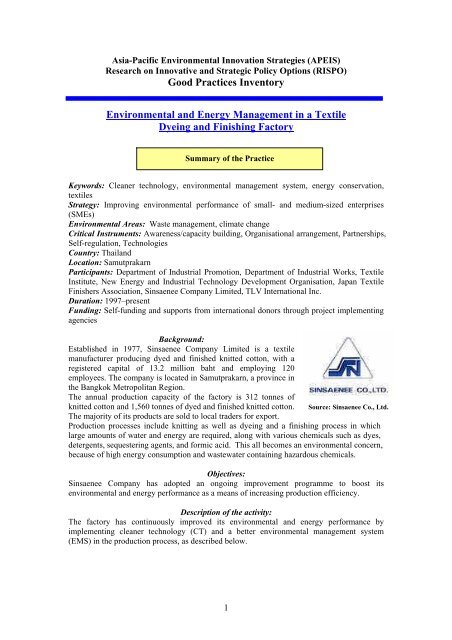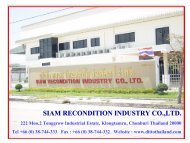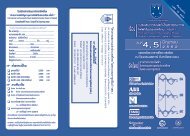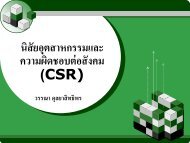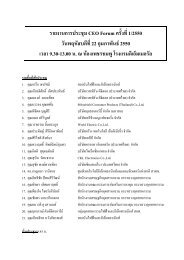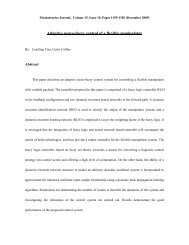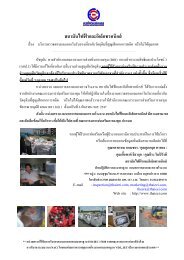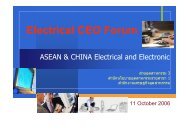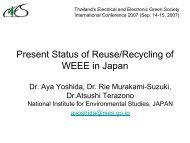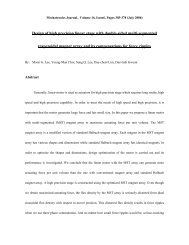Environmental and Energy Management in a Textile Dyeing ... - IGES
Environmental and Energy Management in a Textile Dyeing ... - IGES
Environmental and Energy Management in a Textile Dyeing ... - IGES
Create successful ePaper yourself
Turn your PDF publications into a flip-book with our unique Google optimized e-Paper software.
Asia-Pacific <strong>Environmental</strong> Innovation Strategies (APEIS)<br />
Research on Innovative <strong>and</strong> Strategic Policy Options (RISPO)<br />
Good Practices Inventory<br />
<strong>Environmental</strong> <strong>and</strong> <strong>Energy</strong> <strong>Management</strong> <strong>in</strong> a <strong>Textile</strong><br />
Dye<strong>in</strong>g <strong>and</strong> F<strong>in</strong>ish<strong>in</strong>g Factory<br />
Summary of the Practice<br />
Keywords: Cleaner technology, environmental management system, energy conservation,<br />
textiles<br />
Strategy: Improv<strong>in</strong>g environmental performance of small- <strong>and</strong> medium-sized enterprises<br />
(SMEs)<br />
<strong>Environmental</strong> Areas: Waste management, climate change<br />
Critical Instruments: Awareness/capacity build<strong>in</strong>g, Organisational arrangement, Partnerships,<br />
Self-regulation, Technologies<br />
Country: Thail<strong>and</strong><br />
Location: Samutprakarn<br />
Participants: Department of Industrial Promotion, Department of Industrial Works, <strong>Textile</strong><br />
Institute, New <strong>Energy</strong> <strong>and</strong> Industrial Technology Development Organisation, Japan <strong>Textile</strong><br />
F<strong>in</strong>ishers Association, S<strong>in</strong>saenee Company Limited, TLV International Inc.<br />
Duration: 1997–present<br />
Fund<strong>in</strong>g: Self-fund<strong>in</strong>g <strong>and</strong> supports from <strong>in</strong>ternational donors through project implement<strong>in</strong>g<br />
agencies<br />
Background:<br />
Established <strong>in</strong> 1977, S<strong>in</strong>saenee Company Limited is a textile<br />
manufacturer produc<strong>in</strong>g dyed <strong>and</strong> f<strong>in</strong>ished knitted cotton, with a<br />
registered capital of 13.2 million baht <strong>and</strong> employ<strong>in</strong>g 120<br />
employees. The company is located <strong>in</strong> Samutprakarn, a prov<strong>in</strong>ce <strong>in</strong><br />
the Bangkok Metropolitan Region.<br />
The annual production capacity of the factory is 312 tonnes of<br />
knitted cotton <strong>and</strong> 1,560 tonnes of dyed <strong>and</strong> f<strong>in</strong>ished knitted cotton. Source: S<strong>in</strong>saenee Co., Ltd.<br />
The majority of its products are sold to local traders for export.<br />
Production processes <strong>in</strong>clude knitt<strong>in</strong>g as well as dye<strong>in</strong>g <strong>and</strong> a f<strong>in</strong>ish<strong>in</strong>g process <strong>in</strong> which<br />
large amounts of water <strong>and</strong> energy are required, along with various chemicals such as dyes,<br />
detergents, sequester<strong>in</strong>g agents, <strong>and</strong> formic acid. This all becomes an environmental concern,<br />
because of high energy consumption <strong>and</strong> wastewater conta<strong>in</strong><strong>in</strong>g hazardous chemicals.<br />
Objectives:<br />
S<strong>in</strong>saenee Company has adopted an ongo<strong>in</strong>g improvement programme to boost its<br />
environmental <strong>and</strong> energy performance as a means of <strong>in</strong>creas<strong>in</strong>g production efficiency.<br />
Description of the activity:<br />
The factory has cont<strong>in</strong>uously improved its environmental <strong>and</strong> energy performance by<br />
implement<strong>in</strong>g cleaner technology (CT) <strong>and</strong> a better environmental management system<br />
(EMS) <strong>in</strong> the production process, as described below.<br />
1
Cleaner technology implementation<br />
Introduction of cleaner technology<br />
In the first stage, the company participated <strong>in</strong> a project called “Promotion of Cleaner<br />
Technology <strong>in</strong> Thail<strong>and</strong>,” implemented by the Thail<strong>and</strong> Environment Institute (TEI) with<br />
support from the Danish Cooperation for Environment <strong>and</strong> Development (DANCED) <strong>and</strong><br />
Federal of Thai Industries (FTI). The project focused on water <strong>and</strong> energy conservation<br />
options for implementation <strong>in</strong> the <strong>in</strong>itial stages, as follows:<br />
• replac<strong>in</strong>g worn out pipes;<br />
• <strong>in</strong>stall<strong>in</strong>g steam pip<strong>in</strong>g <strong>in</strong>sulation;<br />
• enhanc<strong>in</strong>g boiler efficiency; <strong>and</strong><br />
• implement<strong>in</strong>g simple good housekeep<strong>in</strong>g<br />
practices such as <strong>in</strong>stall<strong>in</strong>g water meters,<br />
level controllers, <strong>and</strong> flow control nozzles.<br />
Source: Tittaya Waranusantikule, TEI<br />
St<strong>and</strong>ardisation of color-match<strong>in</strong>g procedures.<br />
The company participated <strong>in</strong> the Research Cooperation Project on<br />
Dye<strong>in</strong>g <strong>and</strong> F<strong>in</strong>ish<strong>in</strong>g Industries <strong>in</strong> Thail<strong>and</strong> by Technology of Cleaner<br />
Production, supported by the New <strong>Energy</strong> <strong>and</strong> Industrial Technology<br />
Development Organisation (NEDO), Japan, <strong>and</strong> the Department of<br />
Industrial Promotion (DIP). The project aims to elim<strong>in</strong>ate the re-dye<strong>in</strong>g<br />
process by improv<strong>in</strong>g work<strong>in</strong>g procedures for staff <strong>and</strong> us<strong>in</strong>g<br />
computerised match<strong>in</strong>g devices.<br />
Accurately match<strong>in</strong>g colours is vitally important to the<br />
quality of products. In the project’s implementation, an<br />
expert from Kurabo Industry Company, Japan, conducted a<br />
short-term study to identify opportunities for improvement<br />
<strong>in</strong> the work<strong>in</strong>g procedures of laboratory staff. It was found<br />
that the quality of the colour-match<strong>in</strong>g process was ma<strong>in</strong>ly<br />
based on staff experience. It was also found that factors<br />
affect<strong>in</strong>g the end-result of match<strong>in</strong>g, such as temperature <strong>and</strong><br />
Source: Tittaya Waranusantikule,<br />
TEI<br />
water volume, were not properly controlled, which led to<br />
errors <strong>in</strong> colour match<strong>in</strong>g.<br />
Consequently, st<strong>and</strong>ardised work<strong>in</strong>g procedures, such as measur<strong>in</strong>g <strong>in</strong>strument selection <strong>and</strong><br />
solution preparation, were <strong>in</strong>troduced to ensure more accurate colour match<strong>in</strong>g. In order to<br />
improve work<strong>in</strong>g procedures, laboratory staff were tra<strong>in</strong>ed on how to achieve uniform colour<br />
mixtures. Work<strong>in</strong>g conditions were also carefully controlled; a highly sensitive weightmeasur<strong>in</strong>g<br />
device was moved to an air-conditioned room to avoid disturbances from electric<br />
fans, <strong>and</strong> a computerised colour-match<strong>in</strong>g device was <strong>in</strong>stalled <strong>in</strong> order to enhance match<strong>in</strong>g<br />
efficiency.<br />
Boiler <strong>and</strong> steam trap retrofit<br />
Steam is one of the necessary results of the heat transfer process.<br />
The factory periodically conducts an energy audit <strong>and</strong><br />
benchmark<strong>in</strong>g to monitor <strong>in</strong>efficiencies <strong>in</strong> the process.<br />
Consequently, top management decided to participate <strong>in</strong> the<br />
Steam System Project <strong>in</strong> order to improve energy efficiency <strong>in</strong><br />
the steam generat<strong>in</strong>g <strong>and</strong> recovery system. This development by<br />
S<strong>in</strong>saenee Company was selected as a pilot project for steam<br />
trap <strong>in</strong>stallation. The steam trap is an automatic valve that<br />
catches <strong>and</strong> releases condensate <strong>in</strong>to the pip<strong>in</strong>g systems, thus<br />
prevent<strong>in</strong>g the release of steam <strong>and</strong> ventilat<strong>in</strong>g air <strong>in</strong>to the<br />
system.<br />
Source: Tittaya Waranusantikule,<br />
TEI<br />
2
<strong>Environmental</strong> management system<br />
EMS for SMEs<br />
The company has benefited from improvements <strong>in</strong> their environmental <strong>and</strong> energy efforts<br />
through various activities. The management team decided to establish an environmental <strong>and</strong><br />
energy research <strong>and</strong> development department to be the focal po<strong>in</strong>t for issues concern<strong>in</strong>g<br />
environmental <strong>and</strong> energy improvement. Establishment of this new department marked the<br />
first step <strong>in</strong> the development of an environmental <strong>and</strong> energy management system. Because<br />
the company eventually wanted to achieve ISO 14001 st<strong>and</strong>ards of certification, it decided to<br />
jo<strong>in</strong> the “EMS for SMEs” project implemented by the Department of Industrial Works (DIW)<br />
<strong>and</strong> supported by Deutsche Gesellschaft Für Technische Zusammenarbeit (GTZ). The project<br />
assists companies <strong>in</strong> establish<strong>in</strong>g an environmental management system (EMS) at the factory<br />
level so that they can gradually improve their system until it can atta<strong>in</strong> ISO st<strong>and</strong>ards.<br />
Through this project, the company established its own environmental policy, set objectives<br />
<strong>and</strong> targets, as well as establish<strong>in</strong>g an environmental management plan. These are prerequisite<br />
items for the first phase. The company successfully passed the criteria <strong>and</strong> was granted the<br />
right to use the EMS for SMEs (Phase I) symbol from the DIW. Currently, the company has<br />
moved <strong>in</strong>to the second phase, which is also the last stage of project implementation focus<strong>in</strong>g<br />
on the activities identified dur<strong>in</strong>g Phase I.<br />
Critical Instruments<br />
Overview<br />
Improvements <strong>in</strong> production efficiency <strong>in</strong> S<strong>in</strong>saenee Company are the result of the follow<strong>in</strong>g<br />
<strong>in</strong>struments.<br />
Awareness/capacity-build<strong>in</strong>g<br />
Develop<strong>in</strong>g capacity-build<strong>in</strong>g schemes for staff at every level<br />
Awareness/capacity-build<strong>in</strong>g is one of the significant factors contribut<strong>in</strong>g to better<br />
environmental performance at S<strong>in</strong>saenee Company. It was a critical issue not only for staff<br />
<strong>in</strong>volved <strong>in</strong> the CT <strong>and</strong> EMS implementation but was also an important one for those at the<br />
operations level. The project staff learned concepts of resource efficiency through CT <strong>and</strong><br />
EMS implementation, while operational staff developed more efficient work<strong>in</strong>g procedures.<br />
Organisational arrangements<br />
Establish<strong>in</strong>g environmental <strong>and</strong> energy research <strong>and</strong> development departments<br />
As the company gradually improved its performance through various coord<strong>in</strong>ated<br />
projects, top management realised the necessity of sett<strong>in</strong>g up an environmental <strong>and</strong><br />
energy research <strong>and</strong> development department to undertake tasks <strong>in</strong>volv<strong>in</strong>g the desired<br />
changes. The new department acts as a focal po<strong>in</strong>t for environmental <strong>and</strong> energy<br />
activities <strong>in</strong> the factory. This is a significant milestone <strong>in</strong> develop<strong>in</strong>g environmental <strong>and</strong><br />
energy management systems.<br />
Partnerships<br />
Cooperation of local governmental agencies <strong>and</strong> <strong>in</strong>ternational organisations<br />
The project is under the collaborative framework of various organisations. There were<br />
three ma<strong>in</strong> actors <strong>in</strong>volved: the local agency, the <strong>in</strong>ternational supporter, <strong>and</strong> the<br />
company itself. This k<strong>in</strong>d of jo<strong>in</strong>t <strong>in</strong>itiative encourages knowledge <strong>and</strong> the transfer of<br />
technology to SMEs.<br />
3
Self-regulation<br />
The need for improvement <strong>in</strong> audit<strong>in</strong>g <strong>and</strong> benchmark<strong>in</strong>g<br />
The pr<strong>in</strong>cipal motivation for the company to develop cleaner production methods is the<br />
reduction of costs associated with <strong>in</strong>efficiencies with<strong>in</strong> their operation. Upper<br />
management was able to reduce these costs through energy audit<strong>in</strong>g <strong>and</strong> benchmark<strong>in</strong>g.<br />
These are effective tools for an organisation to monitor the actual performance of their<br />
company, to recognize <strong>in</strong>efficiencies, discover where there is room for improvement, <strong>and</strong><br />
f<strong>in</strong>ally be able to improve performance.<br />
Technologies<br />
Installation of automatic equipment to improve efficiency<br />
Retrofit of the boiler system played an important role <strong>in</strong> improv<strong>in</strong>g the energy efficiency<br />
of the factory, elim<strong>in</strong>at<strong>in</strong>g steam release, <strong>and</strong> improv<strong>in</strong>g efficiency of their equipment.<br />
The improved technology provided a great opportunity for the factory to reduce heat loss<br />
due to the release of steam <strong>and</strong> the accumulation of condensate <strong>in</strong> the pip<strong>in</strong>g system.<br />
Moreover, <strong>in</strong> the colour-match<strong>in</strong>g processes, a computerised colour-match<strong>in</strong>g device was<br />
<strong>in</strong>stalled to enhance speed <strong>and</strong> accuracy, result<strong>in</strong>g <strong>in</strong> fewer defects <strong>and</strong> <strong>in</strong>creased<br />
customer satisfaction. Introduction of these new technologies assisted the company <strong>in</strong><br />
improv<strong>in</strong>g its performance.<br />
Impacts<br />
• The company developed an environmental <strong>and</strong> energy management system as a<br />
management tool <strong>and</strong> a fundamental framework for the company to move toward better<br />
production efficiency. They can thus recognise problems <strong>and</strong> <strong>in</strong>efficiencies, <strong>and</strong><br />
subsequently, they set up a cont<strong>in</strong>u<strong>in</strong>g improvement program.<br />
• Implementation of cleaner technology resulted <strong>in</strong> cost reductions. For example, the boiler<br />
<strong>and</strong> steam trap retrofit led to a 20 percent reduction <strong>in</strong> fuel oil consumption.<br />
• Cleaner technology practices also help <strong>in</strong> <strong>in</strong>creas<strong>in</strong>g customer satisfaction due to better<br />
quality of product <strong>and</strong> services. For example, the colour-match<strong>in</strong>g process can now be<br />
completed with<strong>in</strong> two to three days, whereas it used to require ten to fifteen days.<br />
• Personnel <strong>in</strong>volved <strong>in</strong> establish<strong>in</strong>g environmental <strong>and</strong> energy management systems have<br />
consistently developed the knowledge <strong>and</strong> skills necessary for implementation of resource<br />
energy efficiency. In addition, operational staff have also developed better work<strong>in</strong>g<br />
procedures <strong>in</strong> order to elim<strong>in</strong>ate waste <strong>and</strong> reduce losses <strong>in</strong> the production process.<br />
• S<strong>in</strong>saenee Company can be used as a demonstration model for steam trap retrofit<br />
adaptations so that <strong>in</strong>terested parties <strong>in</strong> other factories could benefit by adopt<strong>in</strong>g this<br />
technology.<br />
Lessons Learned<br />
• A strong commitment from upper management is vitally important for improv<strong>in</strong>g<br />
efficiency <strong>in</strong> manufactur<strong>in</strong>g enterprises. In this case, the manag<strong>in</strong>g director played a key<br />
role <strong>in</strong> promot<strong>in</strong>g organisational changes, which then stimulated employees to actively<br />
participate <strong>in</strong> implementation.<br />
• An environmental <strong>and</strong> energy management system is an effective <strong>in</strong>strument for<br />
cont<strong>in</strong>u<strong>in</strong>g improvements, because it provides the basic tools for systematic monitor<strong>in</strong>g of<br />
performance.<br />
• Performance improvement is a cont<strong>in</strong>uous learn<strong>in</strong>g process <strong>in</strong> which returns from previous<br />
adaptations could be <strong>in</strong>centives that re<strong>in</strong>force further developments <strong>and</strong> better efficiency.<br />
• Improv<strong>in</strong>g environmental <strong>and</strong> energy performance can be seen as a means of <strong>in</strong>creas<strong>in</strong>g<br />
resource efficiency, lead<strong>in</strong>g to cost reductions <strong>and</strong> higher profits. Accord<strong>in</strong>gly, the<br />
4
f<strong>in</strong>ancial return on <strong>in</strong>vestments should be presented as a motivation for SMEs to improve<br />
their operations.<br />
Potential for Application<br />
• Cleaner technology (CT) practices encourage waste reduction <strong>and</strong> greater resource<br />
efficiency. CT implementation thus provides both environmental <strong>and</strong> economic returns. It<br />
is economically feasible for SMEs to adopt CT implementation, particularly <strong>in</strong> practices<br />
that require low <strong>in</strong>vestment with a short payback period.<br />
• Cont<strong>in</strong>u<strong>in</strong>g improvements <strong>in</strong> efficiency at S<strong>in</strong>saenee Company are an on-go<strong>in</strong>g objective<br />
with<strong>in</strong> the factory. This highlights the commitment of upper management as a significant<br />
factor for success.<br />
• Technical knowledge is extremely important for practices that require technology changes.<br />
Therefore, the availability of technology <strong>and</strong> the ability to transfer that knowledge are<br />
crucial issues to be considered.<br />
Contact<br />
S<strong>in</strong>saenee Company Limited<br />
190 Moo 1 Suksawad Road<br />
Prasamutchedi Samutprakarn<br />
Thail<strong>and</strong> 10290<br />
Tel: (662) 425-1270-5<br />
Fax: (662) 425-1276<br />
E-mail: tuta@ji-net.com<br />
Case reviewer: Tittaya Waranusantikule, Research Associate, Thail<strong>and</strong> Environment Institute<br />
(TEI), tittaya@tei.or.th<br />
Information date: 29 September 2003<br />
5


